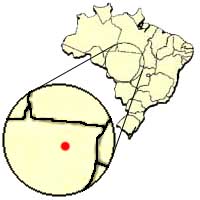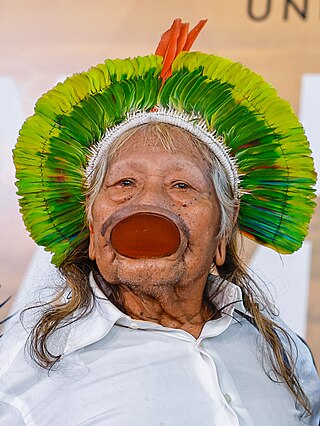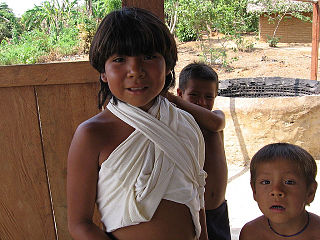
The Xingu are an indigenous people of Brazil living near the Xingu River. They have many cultural similarities despite their different ethnicity. Xingu people represent fifteen tribes and all four of Brazil's indigenous language groups, but they share similar belief systems, rituals and ceremonies.
The Panará are an Indigenous people of Mato Grosso in the Brazilian Amazon. They farm and are hunter-gatherers.
The Xingu Indigenous Park is an indigenous territory of Brazil, first created in 1961 as a national park in the state of Mato Grosso, Brazil. Its official purposes are to protect the environment and the several nations of Xingu Indigenous peoples in the area.
The Trumai are an indigenous people of Brazil. They currently reside within the Xingu Indigenous Park, in the state of Mato Grosso. They have a population of 258 in 2014. They were 97 in 2011 and 120 in 2006, up from a low of 26 in 1966.
The Kuruaya people are an indigenous people of Brazil. They live along the tributaries of the lower Xingu River in the state of Pará.
The Yawalapiti are an indigenous tribe in the Amazonian Basin of Brazil. The name is also spelled Iaualapiti in Portuguese. The current village Yawalapiti is situated more to the south, between the Tuatuari and Kuluene River. Their population in 2011 was 156, down from a 2010 population of 237 (2010) but up from a low of 25 in 1954.
The Yudjá or Juruna are an Indigenous people of Brazil. They were formerly the major tribe along the Xingu River, but are now divided into two groups, a westernized northern group near Altamira, Para near the big bend of the Xingu and a more conservative group in the Xingu Indigenous Park at the headwaters of the Xingu in Mato Grosso. The southern group lives in two villages located near the mouth of the Maritsauá-Mitau River. They fish and raise crops, such as manioc.

The languages of South America can be divided into three broad groups:
The Aweti people are a group of Indigenous Brazilians living in the Xingu Indigenous Park, close to the headwaters of the Xingu River in Brazil. The Aweti inhabit two villages in the region. One is called Tazu’jyretam, and the other is unnamed. Tazu’jyretam is the main village of the Aweti people, and has been inhabited since at least the 19th century. Tazu’jyretam also has a small port. Both of these villages are located in an area between the Curisevo and Tuatuarí rivers, which feed into the Xingu further upstream. Their population was 196 in 2011, up from 140 in 2006.

The Mehinaku, Mehináko or Mehinacu are an indigenous people of Brazil. They live in the Indigenous Park of the Xingu, located around the headwaters of the Xingu River in Mato Grosso. They currently reside in area around the Tuatuari and Kurisevo Rivers. They had a population of 254 in 2011, up slightly from 200 in 2002.

The Kayabí or Kaiabi are an indigenous people of Brazil inhabiting the northern state of Mato Grosso. They primarily live in the Xingu Indigenous Park and the Indian Reservation of Apiaká-Kayabi south of Pará. There are approximately 1300 Kayabí living on the Xingu Indigenous Park. They are known by a number of names; Caiabi, Parua, Maquiri, Kawaiwete and many more romanizations of the word Kaiabi.
The Ikpeng are an indigenous community that now lives in the Xingu Indigenous Park in Mato Grosso, Brazil. They had a population of 459 in 2010, up from a low of 50 in 1969.
The Awetí or Aweti language is one of the Tupian languages of Central Brazil. Spoken by the indigenous people that live along the Upper Xingu River, the language is in danger of becoming extinct with a declining 150 living speakers. The Aweti people live in a multilingual area due to various indigenous people settling there from various regions. In search of refuge many people have relocated to the reserve as a result of European colonialism.
The Arara people, also called Arara do Pará are an indigenous people of Brazil, living in the state of Pará, Brazil. They are known for both their prowess in warfare and trophy-keeping practices, as well as their ability to interact with and accommodate non-native peoples. They maintained a nomadic existence and frequently intermarried with other tribes. The largest Arara settlement is Laranjal village.

Raoni Metuktire, also known as Chief Raoni or Ropni, is an Indigenous Brazilian leader and environmentalist. He is a chief of the Kayapo people, a Brazilian Indigenous group from the plain lands of the Mato Grosso and Pará in Brazil, south of the Amazon River and along Xingu River and its tributaries. He is internationally famous as a living symbol of the fight for the preservation of the Amazon rainforest and indigenous culture.
Kayabí is a Tupian language spoken by the Kayabí people of Mato Grosso, Brazil. Although the Kayabi call themselves Kagwahiva, their language is not part of the Kagwahiva language.
Mehináku (Meinaku) is an Arawakan language spoken by the Mehinaku people in the Xingu Indigenous Park of Brazil. One dialect, Waurá-kumá, is "somewhat intelligible" with Waurá due to influence from this language.
Waurá (Wauja) is an Arawakan language spoken in the Xingu Indigenous Park of Brazil by the Waujá people. It is "partially intelligible" with Mehináku. The entire population speaks the language.

The Araweté are an indigenous people of Brazil. They are swidden horticulturalists native to the state of Pará.
Xingú Asuriní is a Tupi–Guaraní language of the state of Pará, in the Amazon region of Brazil. The entire population speaks the language, and most speakers are monolingual.




